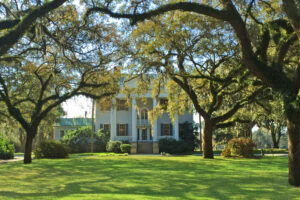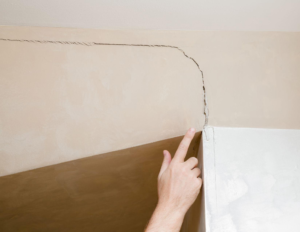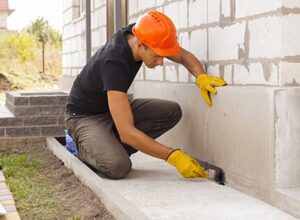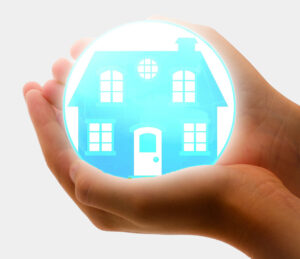Fort Sumter House at 1 King Street began its existence as the Fort Sumter Hotel, which opened to guests in 1924. Designed by prominent commercial architect G. Lloyd Preacher of Atlanta, GA, the Spanish Colonial-style structure was built at a cost of $850,000. The 7-story building is located along the South Battery, directly adjacent to White Point Garden. At its inception, it was the tallest building, as well as the only luxury hotel on the Charleston Peninsula. A 1929 brochure boasts, “spacious lobbies, sun parlors and terraces, comfortable and luxuriously furnished, overlook the water and offer cordial hospitality in an atmosphere to be found in few hotels.”

The second floor featured a grand ballroom and lounge. The ground level housed a dining room, which for many years was one of downtown Charleston’s few restaurants. From 1954-1973, this eatery was called the Rampart Room. It was decorated with images of Southern Colonels and murals of Charleston scenes. A rarity in its time, it touted air conditioning and “manufactured ice” in its drinks.
FAMOUS VISITORS
The Fort Sumter Hotel has had its share of notable guests. John F. Kennedy, then a young Naval intelligence officer, stayed in 1942. While there, he engaged in a tryst with a suspected German spy that was recorded by the FBI. The ensuing scandal changed the course of history. Playwright Tennessee Williams and Producer Irene Selznick visited in 1947. In fact, Williams hand wrote scenes for “A Streetcar Named Desire” on hotel stationery. Between those dates it served as the headquarters for the Sixth Naval District (prior to its move to the old Navy Base), before being remodeled and returned to hotel operation.
 Throughout the 1950s, famed Charleston Renaissance artist Alfred Hutty’s paintings and etchings were on permanent exhibit in the hotel. He even held annual exhibitions there in the hopes of selling this work to the steadily-growing number of tourists in the Holy City. His 1949 mural “Attack on Fort Sumter” occupied a prominent place in the hotel lobby, where a full-sized reproduction still hangs today. (The original can now be found in the auditorium of The Charleston Museum.)
Throughout the 1950s, famed Charleston Renaissance artist Alfred Hutty’s paintings and etchings were on permanent exhibit in the hotel. He even held annual exhibitions there in the hopes of selling this work to the steadily-growing number of tourists in the Holy City. His 1949 mural “Attack on Fort Sumter” occupied a prominent place in the hotel lobby, where a full-sized reproduction still hangs today. (The original can now be found in the auditorium of The Charleston Museum.)
CONDO CONVERSION
In 1967, Sheraton purchased the hotel for $435,000 and spent half a million dollars on renovations. They would be the last corporation to run the Fort Sumter as a hotel. In 1973, a group of local investors bought the property for $850,000 – the same price as it originally cost to build half a century earlier. The Fort Sumter Hotel closed in 1973 and its 225 rooms were converted into 67 condominiums at a cost of $2 million.
The condo conversion required a change in zoning which then-Mayor Palmer Gaillard said would “have a major significance on zoning throughout the city.” A contemporary marketing piece noted that “Fort Sumter House represents the only high-rise structure of its kind in the historic area of the city, local sentiment and strict zoning dictate that no other structures of this height can ever be constructed.” In 2022, the building underwent an extensive $4.5 million renovation. Today, there are 72 residential units and businesses have returned to the ground floor. Fort Sumter House is one of many notable examples of adaptive reuse in this historic city.
 Residents of the building enjoy panoramic views of White Point Gardens, historic Battery mansions, city rooftops and steeples, the Ashley and Cooper Rivers, the Ravenel Bridge, Patriots Point and the Yorktown, and even Fort Sumter and the Atlantic Ocean. The South of Broad location at the corner of King Street and Murray Blvd. can’t be beat. Amenities include on-site security, parking lots, an exercise room, and private palmetto tree-lined pool along the Battery. If you would like to live in this piece of Charleston history, Disher, Hamrick & Myers’s has offered several units for sale in recent years. Give us a call at 843.577.4115 to learn what is available today.
Residents of the building enjoy panoramic views of White Point Gardens, historic Battery mansions, city rooftops and steeples, the Ashley and Cooper Rivers, the Ravenel Bridge, Patriots Point and the Yorktown, and even Fort Sumter and the Atlantic Ocean. The South of Broad location at the corner of King Street and Murray Blvd. can’t be beat. Amenities include on-site security, parking lots, an exercise room, and private palmetto tree-lined pool along the Battery. If you would like to live in this piece of Charleston history, Disher, Hamrick & Myers’s has offered several units for sale in recent years. Give us a call at 843.577.4115 to learn what is available today.
The Fort Sumter House, King Street, Charleston, Charleston County, South Carolina, 29415


 Charleston’s prime location on the waterfront makes it easy to access a variety of water activities. You can enjoy a sunset sail on a charter boat or test your skills by angling for a big fish. Kayak and stand-up paddle board rentals are also quite popular if you want to explore
Charleston’s prime location on the waterfront makes it easy to access a variety of water activities. You can enjoy a sunset sail on a charter boat or test your skills by angling for a big fish. Kayak and stand-up paddle board rentals are also quite popular if you want to explore Visitors and locals alike are quite fond of
Visitors and locals alike are quite fond of  There are many plantations in the Charleston area that date back centuries.
There are many plantations in the Charleston area that date back centuries.  The famous Angel Oak is located just a short drive west from Charleston, on Johns Island. You can’t miss this beautiful tree that is at least 400 years old and covers more than 17,000 square feet. The tree itself is stunning, but there are also other outdoor activities to enjoy on this side of town. Travel a little further up picturesque Maybank Highway to Wadmalaw Island. Here, check out Charleston’s only winery,
The famous Angel Oak is located just a short drive west from Charleston, on Johns Island. You can’t miss this beautiful tree that is at least 400 years old and covers more than 17,000 square feet. The tree itself is stunning, but there are also other outdoor activities to enjoy on this side of town. Travel a little further up picturesque Maybank Highway to Wadmalaw Island. Here, check out Charleston’s only winery, 
 Since most homes in Charleston don’t have basements, identifying water intrusion can be tricky. Homeowners likely won’t find visible water damage, but instead will notice changes in moisture. Moist air typically feels colder in the winter and hotter in the summer, so uncomfortable indoor temperatures can indicate a water intrusion problem.
Since most homes in Charleston don’t have basements, identifying water intrusion can be tricky. Homeowners likely won’t find visible water damage, but instead will notice changes in moisture. Moist air typically feels colder in the winter and hotter in the summer, so uncomfortable indoor temperatures can indicate a water intrusion problem.
 When your student graduates or is moving on, you have several options. You can keep the property as an investment rental. If you have another child who attends the same school, you can make a similar arrangement with him or her. You can also exchange the home for another investment property in another location in a 1031 exchange. Or you can always sell the property and realize any profits from increased value.
When your student graduates or is moving on, you have several options. You can keep the property as an investment rental. If you have another child who attends the same school, you can make a similar arrangement with him or her. You can also exchange the home for another investment property in another location in a 1031 exchange. Or you can always sell the property and realize any profits from increased value. Both homeowner’s insurance and home warranties involve paying a monthly or annual premium for protection for a specific amount of time. Both will protect you financially by covering certain kinds of damage to your home and possessions. When you make a claim, you will be charged a deductible, which is generally customizable with both products. But that’s pretty much where the similarities end.
Both homeowner’s insurance and home warranties involve paying a monthly or annual premium for protection for a specific amount of time. Both will protect you financially by covering certain kinds of damage to your home and possessions. When you make a claim, you will be charged a deductible, which is generally customizable with both products. But that’s pretty much where the similarities end. The other primary difference between home warranties and insurance is that one is mandatory for any homeowner with a mortgage. The financial institution that lends you money to purchase your house will require that you carry homeowner’s insurance as a condition of borrowing. Purchasing a home warranty, on the other hand, is optional.
The other primary difference between home warranties and insurance is that one is mandatory for any homeowner with a mortgage. The financial institution that lends you money to purchase your house will require that you carry homeowner’s insurance as a condition of borrowing. Purchasing a home warranty, on the other hand, is optional. For example, if a water pipe breaks and damages your carpet, the property insurance section of your homeowner’s policy will cover the cost of replacing the carpet. However, it won’t cover the cost of fixing the broken plumbing. By contrast, a home warranty will pay your plumbing bill, but it won’t pay to replace your carpet. Here, you can begin to see why both types of coverage may be beneficial.
For example, if a water pipe breaks and damages your carpet, the property insurance section of your homeowner’s policy will cover the cost of replacing the carpet. However, it won’t cover the cost of fixing the broken plumbing. By contrast, a home warranty will pay your plumbing bill, but it won’t pay to replace your carpet. Here, you can begin to see why both types of coverage may be beneficial. Both homeowner’s insurance and home warranties allow you to tailor certain policy features to suit your needs. For example, with a home warranty, most companies allow you to select coverage for systems, appliances, or both. Some offer pre-set packages, while others let you pick and choose the items you need covered. For example, if you own a pool, you can elect pool repair coverage. Homeowner’s insurance companies also permit you to add “riders” to your policy to cover items that are not normally covered in a basic policy. If you have expensive jewelry or antiques in your home, it’s a good idea to add riders to be fully protected.
Both homeowner’s insurance and home warranties allow you to tailor certain policy features to suit your needs. For example, with a home warranty, most companies allow you to select coverage for systems, appliances, or both. Some offer pre-set packages, while others let you pick and choose the items you need covered. For example, if you own a pool, you can elect pool repair coverage. Homeowner’s insurance companies also permit you to add “riders” to your policy to cover items that are not normally covered in a basic policy. If you have expensive jewelry or antiques in your home, it’s a good idea to add riders to be fully protected. There are two types of property insurance:
There are two types of property insurance: 


 Remote work is becoming the new norm, and it’s continuing longer than most initially expected. Many in the workforce today are discovering they don’t need to live close to the office anymore, and they can get more for their money if they move a little further outside city limits. Lawrence Yun, Chief Economist for the National Association of Realtors (NAR), notes:
Remote work is becoming the new norm, and it’s continuing longer than most initially expected. Many in the workforce today are discovering they don’t need to live close to the office anymore, and they can get more for their money if they move a little further outside city limits. Lawrence Yun, Chief Economist for the National Association of Realtors (NAR), notes: Many school districts are using a model of virtual or hybrid learning, turning their curriculums into digital formats for students. If you have school-age children, they may need a dedicated learning space. If so, it might be time to find a larger home to provide your children with the same kind of quiet room to focus on their schoolwork, just like you need for your office work.
Many school districts are using a model of virtual or hybrid learning, turning their curriculums into digital formats for students. If you have school-age children, they may need a dedicated learning space. If so, it might be time to find a larger home to provide your children with the same kind of quiet room to focus on their schoolwork, just like you need for your office work. Staying healthy and active is a top priority for many Americans. With concern around the safety of returning to fitness facilities, dreams of space for a home gym are growing stronger. The Home Builders Association of Greater New Orleans explains:
Staying healthy and active is a top priority for many Americans. With concern around the safety of returning to fitness facilities, dreams of space for a home gym are growing stronger. The Home Builders Association of Greater New Orleans explains: Especially for those living in an apartment or a small townhouse, outdoor space is a new priority. Zillow notes the benefits of being able to use your yard throughout the year:
Especially for those living in an apartment or a small townhouse, outdoor space is a new priority. Zillow notes the benefits of being able to use your yard throughout the year: Charleston benefits from a subtropical climate with mild winters, hot, humid summers, and plentiful year-round rainfall. This weather provides the ideal conditions for maintaining lush, green gardens that are a calling card of Charleston, SC homes. Centipede, Bermuda, Zoysia, and St. Augustine grasses all thrive in Southern lawns. Magnolia, palmetto, dogwood, and crepe myrtle trees create quintessential Lowcountry charm.
Charleston benefits from a subtropical climate with mild winters, hot, humid summers, and plentiful year-round rainfall. This weather provides the ideal conditions for maintaining lush, green gardens that are a calling card of Charleston, SC homes. Centipede, Bermuda, Zoysia, and St. Augustine grasses all thrive in Southern lawns. Magnolia, palmetto, dogwood, and crepe myrtle trees create quintessential Lowcountry charm.  While concrete driveways are a staple of suburban America, their bland, highly-processed look is not as appropriate in Charleston — especially on the downtown peninsula, which still maintains historic cobblestone streets.
While concrete driveways are a staple of suburban America, their bland, highly-processed look is not as appropriate in Charleston — especially on the downtown peninsula, which still maintains historic cobblestone streets. Charleston is all about colorful homes. In fact, Rainbow Row on East Bay Street, which features homes in various pastel hues, is one of the city’s most popular tourist attractions. However, the
Charleston is all about colorful homes. In fact, Rainbow Row on East Bay Street, which features homes in various pastel hues, is one of the city’s most popular tourist attractions. However, the  With well over 200 days of sunshine each year, Charlestonians have to consider this element in their window choices. It’s a good idea to use low-E and double-paned windows to help control solar radiation entering the house. But don’t forget aesthetic when using these modern materials, especially on days when windows are just meant to be open. Six-over-six double-hung windows were particularly popular in the 18th and 19th centuries, and remain so today. You’ll also find variations on the number of panes throughout the historic district, along with arches (particularly on Palladian windows), and big bay windows. French doors and sliders are other Lowcountry essentials for easy access to the outdoors and letting in fresh air.
With well over 200 days of sunshine each year, Charlestonians have to consider this element in their window choices. It’s a good idea to use low-E and double-paned windows to help control solar radiation entering the house. But don’t forget aesthetic when using these modern materials, especially on days when windows are just meant to be open. Six-over-six double-hung windows were particularly popular in the 18th and 19th centuries, and remain so today. You’ll also find variations on the number of panes throughout the historic district, along with arches (particularly on Palladian windows), and big bay windows. French doors and sliders are other Lowcountry essentials for easy access to the outdoors and letting in fresh air.